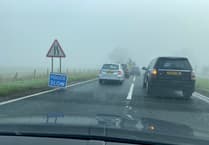Out on a walk with my dog Ruby recently around the Mardens, at the west end of the Downs, we stumbled across a shoot, writes Malinka van der Gaauw.
While their target was pheasant, the sound of gunshot, ringing around the densely wooded hillside, clearly had an unnerving effect on the other inhabitants of this otherwise tranquil area.
As we skirted the large, open field, giving the shoot a wide berth, Ruby couldn’t believe her luck when at least ten deer leapt out of the hedge in front of us.
Given she was on the lead and 12 years old I wasn’t initially concerned, but in the heat of the moment, she somehow managed to slip her collar.
An intervention – or, more accurately, a bellow – was clearly required. To my great satisfaction and pride, she stopped dead in her tracks and returned to my side, with just the slightest look of regret in her eye!
An encounter with deer these days, whether out on a walk or, less fortunately, on the road, is fast becoming a normal occurrence.
The UK’s deer population is believed to be at its highest level for 1,000 years, with some two million deer in our countryside and semi-urban areas.
In conversation recently with the Steve Walker of Natural England, with responsibility for the western end of the Downs, including Kingley Vale, I learned he’d spent the previous night up on the Downs thermal imaging the fallow deer population with the tech wizards from Digital Fauna.
The local herds have apparently got so clever at avoiding detection that after nightfall is the best time for getting concrete evidence.
The image on this page clearly show how large some of the herds have become.
While the Downs are not part of the reserve, these herds roam vast areas of the Hampshire/West Sussex borderlands, of which the Mardens and Kingley Vale are part.
Unfortunately, at Kingley Vale the future of the famous yews is under threat from the deer. Yew is well-known for its longevity and regeneration properties, but even it needs to produce new shoots for the long-term survival of the forest.
With the young, juicy stems being eaten by the deer, the age diversity of the grove is being put at risk.
Similarly, most of the woodland understorey has been browsed off. This is already leading to the decline of wildflowers, insects and woodland birds such as the nightingale, nightjar, bullfinch and marsh tit, which all rely on this layer for feeding or breeding.
The nature reserve is also home to an active dew pond restoration programme. Traditionally, their saucer-like design provided sheep with a safe means of accessing water, but their fragile ecology cannot cope with vast herds of deer descending for a drink.
Barriers have had to be erected to stop them from eating all the marginal plants, which other wetland species rely on.
Another problem, associated with wild deer, that walkers will surely have come across in recent years, are the ticks they carry.
Although deer are a beautiful part of our woodland ecology, in the absence of a natural predator, like the lynx, their population needs to be managed.
This can only realistically be done by man in an ‘enlightened nature-mimicking way’. This will not only stop damage being done to protected areas, farmland and forestry, but also ensure the herds themselves remain healthy.
However, the ‘bambi-effect’ is a significant hurdle to a humane cull. Furthermore, even if it was considered publicly acceptable, Covid and Brexit have dealt a blow to the venison market.
If we are to solve all these problems, conventional wisdom suggests we need to start eating more venison. This will help drive up demand for deer carcasses and make it economically viable for stalkers to carry out a selective cull.
As a food source, venison ticks many of the key boxes – it is low in fat and carbon, high in protein and welfare, and full of iron, zinc and B vitamins.
If you are yet to give venison a go, perhaps you might be tempted to try it the next time you are out for a meal.
If anyone questions your gluttony as you tuck into a venison steak or burger, your rebuttal is clear – you are doing your bit to protect the South Downs, just as Ruby had clearly been hoping to do on our walk!




